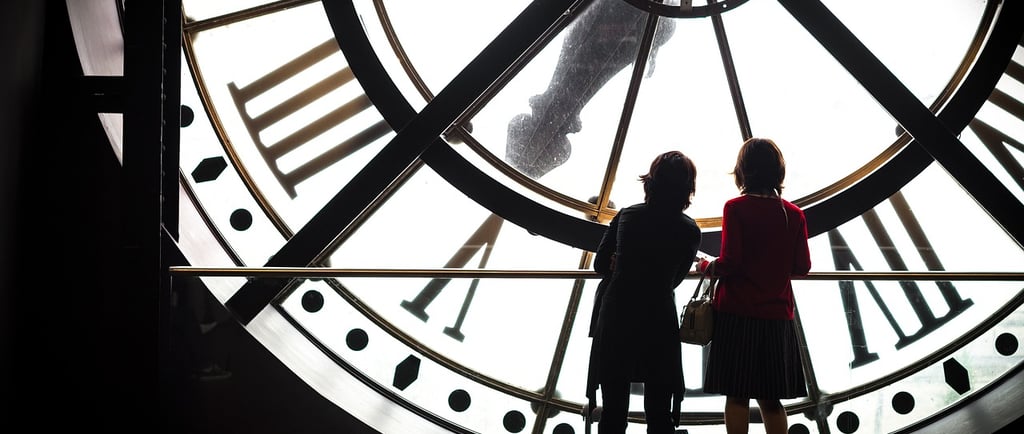🌞 The Story of Daylight Saving Time: How We Learned to “Save” Light! 🌞
🌞 A follow-up story that connects the Towards an Understanding of Linear Time chapter in the History Album. ⏳✨ It invites children to notice winter’s early sunsets and meet William Willett, who wondered if shifting the clock could help people enjoy more evening light—and, during World War I, help communities save precious coal—planting the seed for Daylight Saving Time. From there, children see how some places still “spring forward” and “fall back,” while others don’t, revealing that timekeeping is a human choice layered atop the sun’s rhythms. This story gently invites children to track tomorrow’s sunrise and sunset, noticing how the sun, the time, and the seasons are connected. What do you spot on your chart this week—is the day getting longer or shorter, and when do you most enjoy the light, morning or evening? 🕰️🌞 🕰️🌞
HISTORY STORIES
10/25/20243 min read


Have you noticed that as we get closer to winter, it starts getting dark earlier and earlier? It feels like the day is shrinking and getting smaller and smaller in the Northern Hemisphere! 🌙 I wonder why that happens? And what do we do when it’s dark? We simply turn on a light, right? 💡 But here’s something interesting to think about: What did people do in times when turning on a light wasn’t so easy or common? 🤔 Well, I have a story for you!
Over 100 years ago, people used coal to power everything—lights, trains, factories, and even their homes. One bright summer morning, one builder named William Willett was out for an early walk. 🌄 He noticed something odd: even though the sun was shining brightly, most people were still asleep indoors! 🌞 He thought, “What if we could change the clocks so people would wake up with the sun and have more fun—in the long summer evenings?” William wrote down his idea in a little booklet called “The Waste of Daylight.” Many people loved his idea, but it didn’t become a law right away.
Then came World War I. Coal, which was needed for power, was suddenly very precious and hard to get. People remembered William’s idea of “saving daylight” and decided to give it a try! 🌅 By moving clocks forward in the spring, people could use natural sunlight for longer in the evening, which helped save coal. Germany was the first country to make Daylight Saving Time (DST) a law. Soon, other countries around the world followed this example and established the same law. 🌍
Depending on where you live, you may tell the story a little differently:
For USA except Hawaii and Arizona
In modern days, every second Sunday in March, we “spring forward” ⏩ by moving our clocks one hour ahead. Then, on the first Sunday in November, we “fall back”⏪ by moving our clocks one hour back. But here’s something very very strange: not every country follows this idea, just 77 countries from 195. 🌏 Countries like Japan, most of Africa, South America and large parts of Asia don’t change their clocks at all! So, why do you think some places join DST, while others decide not to? 🌞 Could it be how close they are to the equator, where the length of day and night doesn’t change as much? Or maybe because they have plenty of energy sources? What would you choose if you were in charge of the clocks?
For Europe
In modern days, every last Sunday in March, we “spring forward” ⏩ by moving our clocks one hour ahead. Then, on the last Sunday in October, we “fall back”⏪ by moving our clocks one hour back. But here’s something very very strange: not every country follows this idea, just 77 countries from 195. 🌏 Countries like Japan, most of Africa, South America and large parts of Asia don’t change their clocks at all! So, why do you think some places join DST, while others decide not to? 🌞 Could it be how close they are to the equator, where the length of day and night doesn’t change as much? Or maybe because they have plenty of energy sources? What would you choose if you were in charge of the clocks?
Questions to wonder aloud:
🌞 Seasons and the Movement of the Sun: Have you ever wondered why we change the clocks in March and November? Why not on the summer solstice in June, when the day is longest, or the equinoxes in March and September, when day and night are equal? 🌙
🦌 Plants, Animals, and Seasonal Light Changes: Animals and plants have their own ways of knowing when seasons change! Do you know which animals start preparing for winter as the days get shorter? How do they get ready? 🦉
💡 Energy Conservation: Why do we change the clocks to ‘save’ daylight? It turns out, it can help save energy! How is modern electricity made? Do we still depend on coal, or have we invented other ways to power our homes and light our cities? 🌆
🛌 Circadian Rhythms and Human Sleep: Have you ever felt really tired after the sun goes down, even if it’s not your bedtime? That’s your body’s clock, called a circadian rhythm! ⏰ It follows sunlight to help you feel sleepy or awake. Do animals have circadian rhythm?
P.S. This story was inspired by a very special friend, Montessorian and storyteller: Hadar Peled ✨
With Montessori joy,
Vanina 😊

